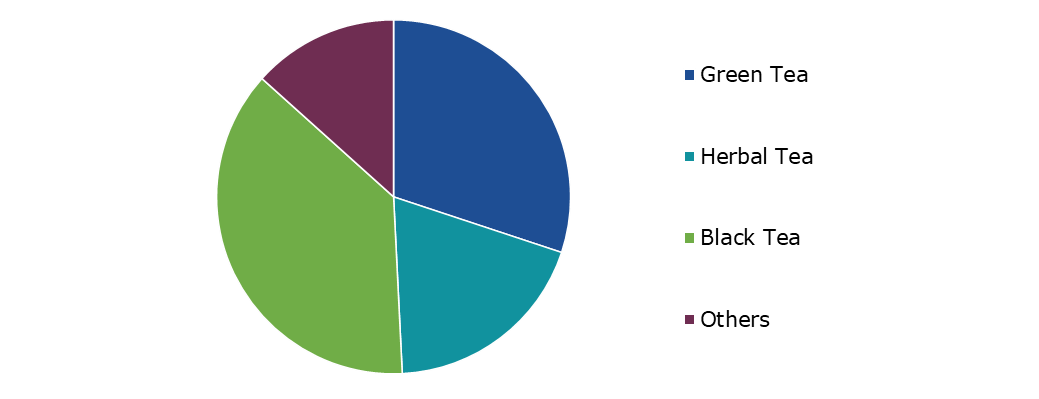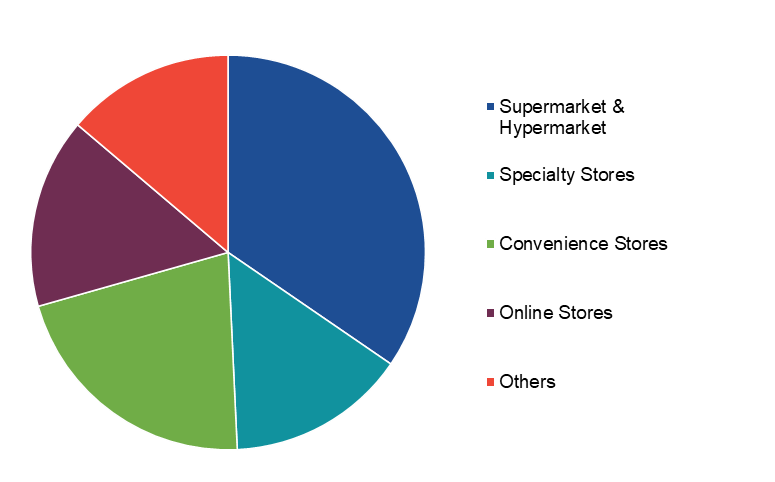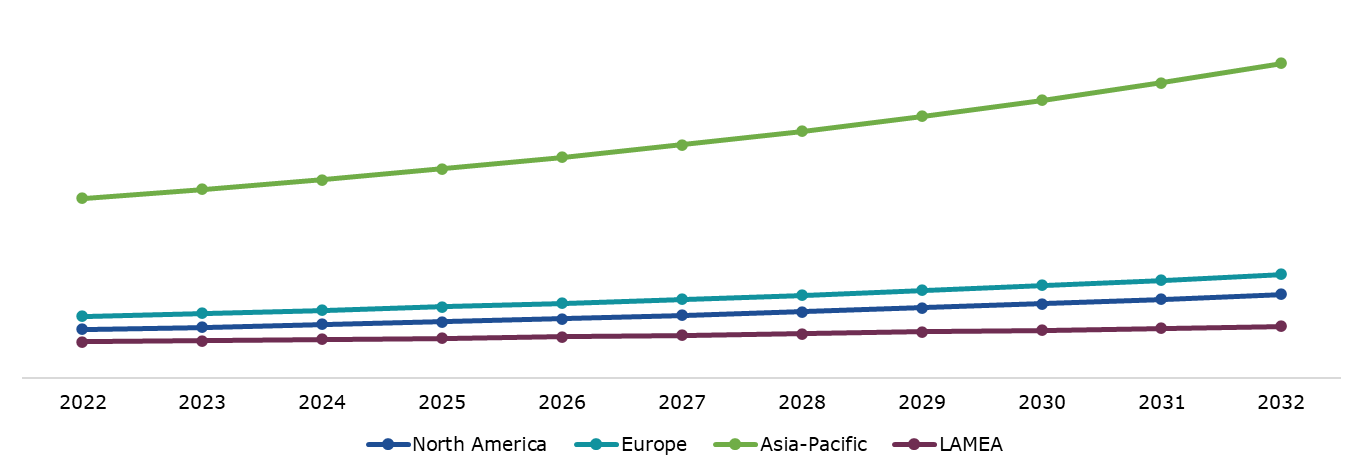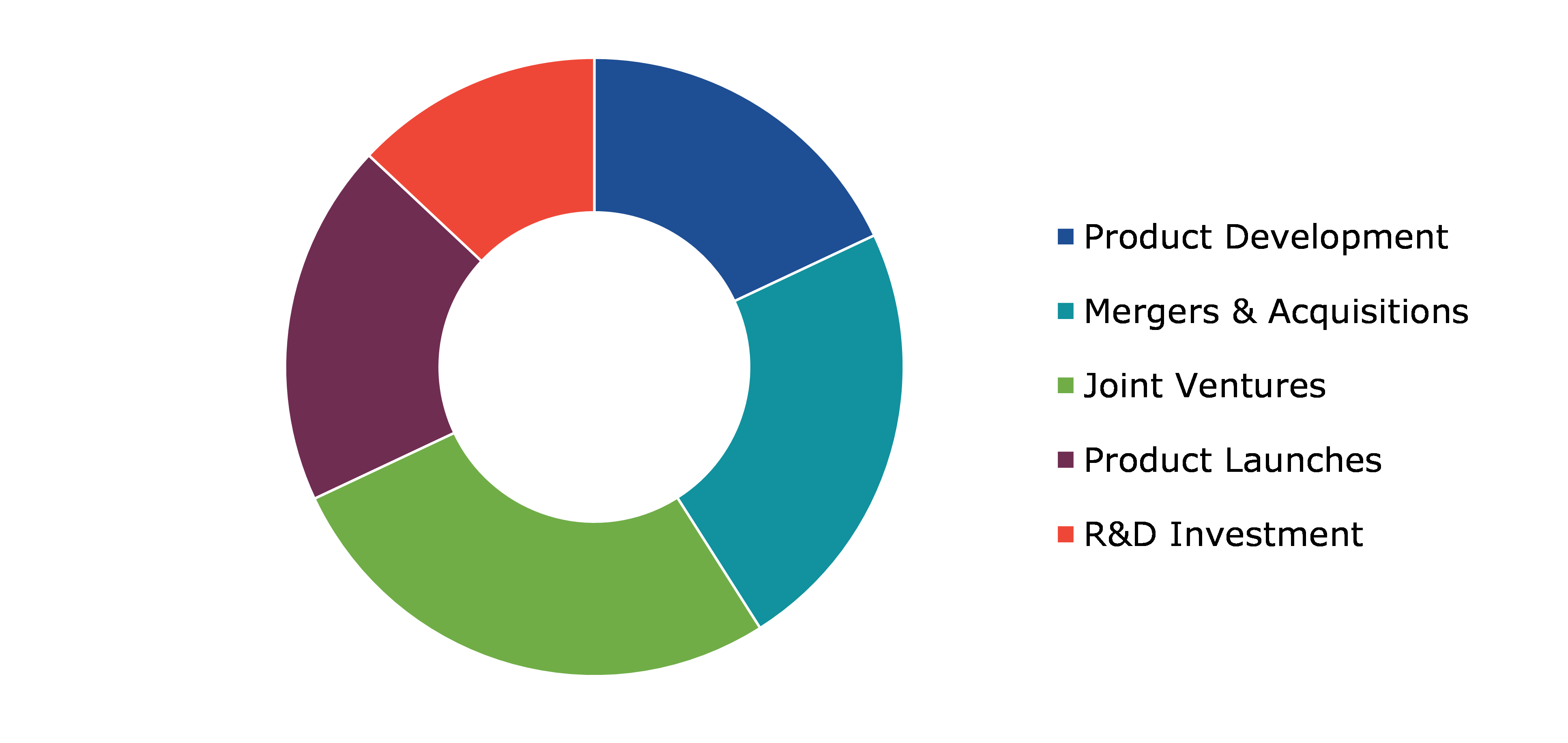Tea Pod Market Report
RA09210
Tea Pod Market by Type (Soft Tea Pods and Hard Tea Pods), Tea Type (Green Tea, Herbal Tea, Black Tea, and Others), Distribution Channel (Supermarket & Hypermarket, Specialty Stores, Convenience Stores, Online Stores, and Others), and Region (North America, Europe, Asia-Pacific, and LAMEA): Global Opportunity Analysis and Industry Forecast, 2023-2032
Tea Pod Overview
Tea pods offer a convenient and efficient way to drink a variety of tea flavors without the difficulty of traditional brewing methods. These pods, typically designed for single-use in compatible machines, encapsulate finely ground tea leaves, ensuring optimal freshness and flavor preservation until consumption. With a diverse range of options available, tea enthusiasts can explore an array of flavors, from classic black and green teas to herbal infusions and specialty blends. The simplicity of tea pods makes them particularly appealing for busy individuals seeking a quick and consistent tea-drinking experience. In addition, their pre-portioned nature minimizes waste and simplifies cleanup, making them an environmentally friendly choice compared to traditional tea bags or loose leaf teas. Furthermore, the growing popularity of tea pods has spurred innovation in both flavor profiles and pod designs, catering to a wide range of preferences and dietary requirements, including options for decaffeinated and organic teas. As consumers increasingly prioritize convenience without compromising on quality, tea pods emerge as a versatile solution that integrates into modern lifestyles, providing an enchanting and convenient tea experience at home or at workplace.
Global Tea Pod Market Analysis
The global tea pod market size was $4,575.0 million in 2022 and is predicted to grow with a CAGR of 5.5%, by generating a revenue of $7,790.4 million by 2032.
Source: Research Dive Analysis
Growing Popularity of Black Tea to Drive the Market Growth
The market for black tea is experiencing a significant surge in popularity, driving substantial growth in the industry. According to India Trade Portal, India is the second largest tea producer globally, and the country’s black tea export held dominant share of the export that is approximately 96% during 2021-2022. This increase can be attributed to several factors, including evolving consumer preferences, increasing awareness regarding its health benefits, and its versatility in various culinary and beverage applications. Black tea, renowned for its robust flavor profile and rich aroma, has captivated a widening audience globally. Its rise in popularity is evident across diverse demographics, reflecting its broad appeal and adaptability to different cultural contexts. As tea pod eases the brewing process, there is an increase in adoption for tea pods in restaurants and cafes, where there is high demand for tea. Moreover, increased interest in natural and traditional remedies has further propelled the consumption of black tea, as it is often associated with various health benefits, including antioxidant properties and potential cardiovascular health advantages. As consumers seek healthier alternatives to sugary beverages and caffeinated options, black tea emerges as a preferred choice, offering a refreshing and invigorating experience without compromising on taste or quality. With an increasing emphasis on wellness and mindful consumption, the trajectory of the black tea market points towards sustained expansion, presenting ample opportunities for producers, retailers, and consumers to engage with and benefit from this flourishing industry. This would simultaneously support the demand for tea pod to cater down the market growth owing to the benefits of tea pod.
Competition from Traditional Tea Bags to Restrain the Market Growth
While the convenience of tea pods is definite, traditional tea bags maintain their popularity due to their affordability and abundant presence in the market. Convincing consumers to transition from the familiarity of tea bags to the relatively newer concept of tea pods poses a significant challenge. Despite the attraction of convenience, consumers often prioritize cost-effectiveness and accessibility when making purchasing decisions, both of which traditional tea bags excel in. Moreover, many consumers have established routines and preferences regarding tea preparation, making them reluctant to adopt a new method. To overcome these obstacles, tea pod manufacturers must emphasize the unique advantages of their product, such as enhanced flavor profiles, reduced waste, and customizable brewing options. In addition, strategic pricing and widespread distribution channels have helped bridging the gap between traditional tea bags and tea pods, making the transition more appealing to a broader audience. Ultimately, successful promotion of tea pods requires a delicate balance between highlighting their benefits and addressing consumer concerns, fostering a gradual but steady shift towards embracing this innovative tea brewing method.
Wide Range of Tea Flavors and Blends in Pod Format to Drive Excellent Opportunities
The introduction of a wide range of tea flavors and blends in pod format presents a favorable landscape with opportunities. These innovative flavors cater to the modern consumer's desire for convenience without compromising on quality or variety. With pods becoming increasingly popular due to their simplicity and efficiency, the integration of diverse tea options taps into a surging market. The versatility of pod-based tea offerings allows for exploration and experimentation, appealing to a broad spectrum of tastes and preferences. From classic favorites like Earl Grey and English Breakfast to exotic blends such as chai latte and fruity infusions, the catalogue of choices ensures the need for wide range of customer base with different taste requirement. Moreover, the convenience of pod-format tea enhances accessibility, whether enjoyed at home, in the office, or on the go. This trend not only addresses the demand for convenience but also caters to health-conscious consumers seeking natural, high-quality ingredients. By offering an assortment of flavors and blends in pod format, tea brands capitalize on this growing market, driving sales and fostering brand loyalty.
Global Tea Pod Market, by Type, 2022
Source: Research Dive Analysis
The soft tea pods sub-segment accounted for the highest market share in 2022. This significant market presence highlights the growing preference among consumers for the convenience and ease offered by soft tea pods. With their user-friendly design and hassle-free brewing process, soft tea pods have emerged strongly with modern lifestyles characterized by time constraints and a demand for simplicity. This dominance suggests a fundamental shift in consumer behavior towards seeking efficient solutions without compromising on quality or flavor. Manufacturers and retailers have recognized this trend and are increasingly investing in the development and promotion of soft tea pod products to capitalize on the expanding market opportunity. As competition intensifies within the tea industry, companies are strategically positioning themselves to leverage the popularity of soft tea pods, employing innovative marketing strategies and product enhancements to capture a larger market share. With the soft tea pods sub-segment leading the way, the tea market is poised for continued growth and evolution, driven by consumer preferences for convenience-driven beverage options.
Global Tea Pod Market, by Tea Type, 2022
Source: Research Dive Analysis
The black tea sub-segment accounted for the highest market share in 2022. The tea pod market has witnessed significant shifts, with the black tea sub-segment emerging as the frontrunner in terms of market dominance. The black tea has asserted its popularity and relevance among consumers. The robust flavor profile and invigorating aroma of black tea have solidified its position as a staple choice for tea enthusiasts worldwide. The rise of the black tea sub-segment reflects not only a preference for tradition but also a growing appreciation for its health benefits and cultural significance. As consumers increasingly seek authenticity and quality in their tea experiences, black tea provides that assurance, offering an enriching taste experience. This market dominance highlights a broader shift in consumer behavior towards embracing classic favorites amidst a sea of innovation. As the tea pod market continues to evolve, the stable popularity of black tea serves as evidence to its enduring legacy and firm appeal.
Global Tea Pod Market, by Distribution Channel, 2022
Source: Research Dive Analysis
The supermarket & hypermarket sub-segment accounted for the highest market share in 2022. Supermarkets and hypermarkets serve as central hubs for consumer convenience, offering a wide array of tea pod options at the same place. Their expansive reach, along with strategic placement in key locations, ensures increased accessibility for consumers seeking tea pod products. Moreover, these retail giants often leverage their extensive marketing resources to promote tea pod offerings, further solidifying their market stronghold. Therefore, consumers are drawn to the convenience and variety offered by these establishments, driving substantial sales within the tea pod market. The supermarket and hypermarket distribution channel segment's supremacy not only reflects consumer preferences but also highlights the importance of retail channels in driving the growth and expansion of the tea pod market. As competition intensifies and consumer demands evolve, this segment's ability to adapt and innovate will remain crucial in sustaining its leading position within the market.
Global Tea Pod Market Size & Forecast, by Region, 2022-2032 ($Million)
Source: Research Dive Analysis
The Asia-Pacific tea pod market generated the highest revenue in 2022. This region, encompassing diverse markets ranging from China and India to Japan and Australia, experienced a surge in demand for convenient tea consumption solutions, propelling its tea pod sector. The growth in region’s revenue highlights the profound cultural significance and widespread adoption of tea consumption throughout the region. Factors such as changing lifestyles, increasing urbanization, and a growing preference for convenience among consumers have boosted the market's growth trajectory. Furthermore, the region's rich tea heritage and traditions have fostered a deep-rooted appreciation for tea, making it a staple beverage choice for millions. The dominance of the Asia-Pacific tea pod market signifies not only its economic importance but also reflects the resilience and adaptability of the tea industry in meeting evolving consumer preferences.
Competitive Scenario in the Global Tea Pod Market
Product launch, investment, and acquisition are common strategies followed by major market players. For instance, in July 2021, Keurig Dr Pepper transformed coffee brewing with the introduction of BrewID, an innovative technology platform aimed at delivering the cup of coffee tailored to individual preferences. The K-Supreme Plus SMART brewer, featuring BrewID, is now accessible on Keurig.com, marking a significant advancement in coffee brewing technology. BrewID's intuitive system recognizes the specific brand and roast of the K-Cup pod being used, automatically adjusting the brew settings to align with the recommendations of the coffee expert who curated it. With over 900 K-Cup pod varieties available in the Keurig system, BrewID ensures a consistently delightful coffee experience with each cup. Moreover, consumers are empowered to further customize their brews, fine-tuning factors such as temperature, strength, and size to suit their personal tastes. This blend of precision and personalization promises a rich, full-flavored coffee experience that caters to the diverse preferences of coffee enthusiasts. Keurig Dr Pepper's BrewID technology represents a leap forward in the pursuit of coffee perfection, offering consumers unparalleled control over their brewing process and delivering an exceptional cup of coffee, every time.
Source: Research Dive Analysis
Some of the leading tea pod market players are Bigelow Tea Co., Nestle SA, Keurig Dr Pepper Inc., Cornish Tea & Cornish Coffee Ltd., Red Diamond Inc., Teekanne GMBH & Co. KG, the Republic of Tea Inc., Starbucks Corporation, Reily Foods Company (RFC), and Lipton Teas & Infusions.
| Aspect | Particulars |
| Historical Market Estimations | 2020-2021 |
| Base Year for Market Estimation | 2022 |
| Forecast Timeline for Market Projection | 2023-2032 |
| Geographical Scope | North America, Europe, Asia-Pacific, and LAMEA |
| Segmentation by Type |
|
| Segmentation by Tea Type |
|
| Segmentation by Distribution Channel |
|
| Key Companies Profiled |
|
Q1. What is the size of the global tea pod market?
A. The size of the global tea pod market was $4,575.0 million in 2022 and is projected to reach $7,789.9 million by 2032.
Q2. Which are the major companies in the tea pod market?
A. Bigelow Tea Co., Nestle SA, Keurig Dr Pepper Inc., Cornish Tea & Cornish Coffee Ltd., Red Diamond Inc., Teekanne GMBH & Co. KG, the Republic of Tea Inc., Starbucks Corporation, Reily Foods Company (RFC), and Lipton Teas & Infusions are some of the key players in the global tea pod market.
Q3. Which region, among others, possesses greater investment opportunities in the future?
A. Asia-Pacific possesses great investment opportunities for investors in the future.
Q4. What will be the growth rate of the Asia-Pacific tea pod market?
A. The Asia-Pacific tea pod market is anticipated to grow at 5.9% CAGR during the forecast period.
Q5. What are the strategies opted by the leading players in this market?
A. Continuous improvement and acquisition are the two key strategies opted by the operating companies in this market.
Q6. Which companies are investing more in R&D activities?
A. Nestle SA and Keurig Dr Pepper Inc. are the companies investing more on R&D activities for developing new products and technologies.
1. Research Methodology
1.1. Desk Research
1.2. Real time insights and validation
1.3. Forecast model
1.4. Assumptions and forecast parameters
1.5. Market size estimation
1.5.1. Top-down approach
1.5.2. Bottom-up approach
2. Report Scope
2.1. Market definition
2.2. Key objectives of the study
2.3. Market segmentation
3. Executive Summary
4. Market Overview
4.1. Introduction
4.2. Growth impact forces
4.2.1. Drivers
4.2.2. Restraints
4.2.3. Opportunities
4.3. Market value chain analysis
4.3.1. List of manufacturers
4.3.2. List of distributors
4.4. Innovation & sustainability matrices
4.4.1. Technology matrix
4.4.2. Regulatory matrix
4.5. Porter’s five forces analysis
4.5.1. Bargaining power of suppliers
4.5.2. Bargaining power of consumers
4.5.3. Threat of substitutes
4.5.4. Threat of new entrants
4.5.5. Competitive Rivalry Intensity
4.6. PESTLE analysis
4.6.1. Political
4.6.2. Economical
4.6.3. Social
4.6.4. Technological
4.6.5. Legal
4.6.6. Environmental
4.7. Impact of COVID-19 on the Tea Pod Market
4.7.1. Pre-covid market scenario
4.7.2. Post-covid market scenario
5. Tea Pod Market Analysis, by Type
5.1. Overview
5.2. Soft Tea Pods
5.2.1. Definition, key trends, growth factors, and opportunities
5.2.2. Market size analysis, by region, 2022-2032
5.2.3. Market share analysis, by country, 2022-2032
5.3. Hard Tea Pods
5.3.1. Definition, key trends, growth factors, and opportunities
5.3.2. Market size analysis, by region, 2022-2032
5.3.3. Market share analysis, by country, 2022-2032
5.4. Research Dive Exclusive Insights
5.4.1. Market attractiveness
5.4.2. Competition heatmap
6. Tea Pod Market Analysis, by Tea Type
6.1. Overview
6.2. Green Tea
6.2.1. Definition, key trends, growth factors, and opportunities
6.2.2. Market size analysis, by region, 2022-2032
6.2.3. Market share analysis, by country, 2022-2032
6.3. Herbal Tea
6.3.1. Definition, key trends, growth factors, and opportunities
6.3.2. Market size analysis, by region, 2022-2032
6.3.3. Market share analysis, by country, 2022-2032
6.4. Black Tea
6.4.1. Definition, key trends, growth factors, and opportunities
6.4.2. Market size analysis, by region, 2022-2032
6.4.3. Market share analysis, by country, 2022-2032
6.5. Others
6.5.1. Definition, key trends, growth factors, and opportunities
6.5.2. Market size analysis, by region, 2022-2032
6.5.3. Market share analysis, by country, 2022-2032
6.6. Research Dive Exclusive Insights
6.6.1. Market attractiveness
6.6.2. Competition heatmap
7. Tea Pod Market Analysis, by Distribution Channel
7.1. Overview
7.2. Supermarket & Hypermarket
7.2.1. Definition, key trends, growth factors, and opportunities
7.2.2. Market size analysis, by region, 2022-2032
7.2.3. Market share analysis, by country, 2022-2032
7.3. Specialty Stores
7.3.1. Definition, key trends, growth factors, and opportunities
7.3.2. Market size analysis, by region, 2022-2032
7.3.3. Market share analysis, by country, 2022-2032
7.4. Convenience Stores
7.4.1. Definition, key trends, growth factors, and opportunities
7.4.2. Market size analysis, by region, 2022-2032
7.4.3. Market share analysis, by country, 2022-2032
7.5. Online Stores
7.5.1. Definition, key trends, growth factors, and opportunities
7.5.2. Market size analysis, by region, 2022-2032
7.5.3. Market share analysis, by country, 2022-2032
7.6. Others
7.6.1. Definition, key trends, growth factors, and opportunities
7.6.2. Market size analysis, by region, 2022-2032
7.6.3. Market share analysis, by country, 2022-2032
7.7. Research Dive Exclusive Insights
7.7.1. Market attractiveness
7.7.2. Competition heatmap
8. Tea Pod Market, by Region
8.1. North America
8.1.1. U.S.
8.1.1.1. Market size analysis, by Type, 2022-2032
8.1.1.2. Market size analysis, by Tea Type, 2022-2032
8.1.1.3. Market size analysis, by Distribution Channel, 2022-2032
8.1.2. Canada
8.1.2.1. Market size analysis, by Type, 2022-2032
8.1.2.2. Market size analysis, by Tea Type, 2022-2032
8.1.2.3. Market size analysis, by Distribution Channel, 2022-2032
8.1.3. Mexico
8.1.3.1. Market size analysis, by Type, 2022-2032
8.1.3.2. Market size analysis, by Tea Type, 2022-2032
8.1.3.3. Market size analysis, by Distribution Channel, 2022-2032
8.1.4. Research Dive Exclusive Insights
8.1.4.1. Market attractiveness
8.1.4.2. Competition heatmap
8.2. Europe
8.2.1. Germany
8.2.1.1. Market size analysis, by Type, 2022-2032
8.2.1.2. Market size analysis, by Tea Type, 2022-2032
8.2.1.3. Market size analysis, by Distribution Channel, 2022-2032
8.2.2. UK
8.2.2.1. Market size analysis, by Type, 2022-2032
8.2.2.2. Market size analysis, by Tea Type, 2022-2032
8.2.2.3. Market size analysis, by Distribution Channel, 2022-2032
8.2.3. France
8.2.3.1. Market size analysis, by Type, 2022-2032
8.2.3.2. Market size analysis, by Tea Type, 2022-2032
8.2.3.3. Market size analysis, by Distribution Channel, 2022-2032
8.2.4. Spain
8.2.4.1. Market size analysis, by Type, 2022-2032
8.2.4.2. Market size analysis, by Tea Type, 2022-2032
8.2.4.3. Market size analysis, by Distribution Channel, 2022-2032
8.2.5. Italy
8.2.5.1. Market size analysis, by Type, 2022-2032
8.2.5.2. Market size analysis, by Tea Type, 2022-2032
8.2.5.3. Market size analysis, by Distribution Channel, 2022-2032
8.2.6. Rest of Europe
8.2.6.1. Market size analysis, by Type, 2022-2032
8.2.6.2. Market size analysis, by Tea Type, 2022-2032
8.2.6.3. Market size analysis, by Distribution Channel, 2022-2032
8.2.7. Research Dive Exclusive Insights
8.2.7.1. Market attractiveness
8.2.7.2. Competition heatmap
8.3. Asia-Pacific
8.3.1. China
8.3.1.1. Market size analysis, by Type, 2022-2032
8.3.1.2. Market size analysis, by Tea Type, 2022-2032
8.3.1.3. Market size analysis, by Distribution Channel, 2022-2032
8.3.2. Japan
8.3.2.1. Market size analysis, by Type, 2022-2032
8.3.2.2. Market size analysis, by Tea Type, 2022-2032
8.3.2.3. Market size analysis, by Distribution Channel, 2022-2032
8.3.3. India
8.3.3.1. Market size analysis, by Type, 2022-2032
8.3.3.2. Market size analysis, by Tea Type, 2022-2032
8.3.3.3. Market size analysis, by Distribution Channel, 2022-2032
8.3.4. Australia
8.3.4.1. Market size analysis, by Type, 2022-2032
8.3.4.2. Market size analysis, by Tea Type, 2022-2032
8.3.4.3. Market size analysis, by Distribution Channel, 2022-2032
8.3.5. South Korea
8.3.5.1. Market size analysis, by Type, 2022-2032
8.3.5.2. Market size analysis, by Tea Type, 2022-2032
8.3.5.3. Market size analysis, by Distribution Channel, 2022-2032
8.3.6. Rest of Asia-Pacific
8.3.6.1. Market size analysis, by Type, 2022-2032
8.3.6.2. Market size analysis, by Tea Type, 2022-2032
8.3.6.3. Market size analysis, by Distribution Channel, 2022-2032
8.3.7. Research Dive Exclusive Insights
8.3.7.1. Market attractiveness
8.3.7.2. Competition heatmap
8.4. LAMEA
8.4.1. Brazil
8.4.1.1. Market size analysis, by Type, 2022-2032
8.4.1.2. Market size analysis, by Tea Type, 2022-2032
8.4.1.3. Market size analysis, by Distribution Channel, 2022-2032
8.4.2. UAE
8.4.2.1. Market size analysis, by Type, 2022-2032
8.4.2.2. Market size analysis, by Tea Type, 2022-2032
8.4.2.3. Market size analysis, by Distribution Channel, 2022-2032
8.4.3. Saudi Arabia
8.4.3.1. Market size analysis, by Type, 2022-2032
8.4.3.2. Market size analysis, by Tea Type, 2022-2032
8.4.3.3. Market size analysis, by Distribution Channel, 2022-2032
8.4.4. South Africa
8.4.4.1. Market size analysis, by Type, 2022-2032
8.4.4.2. Market size analysis, by Tea Type, 2022-2032
8.4.4.3. Market size analysis, by Distribution Channel, 2022-2032
8.4.5. Rest of LAMEA
8.4.5.1. Market size analysis, by Type, 2022-2032
8.4.5.2. Market size analysis, by Tea Type, 2022-2032
8.4.5.3. Market size analysis, by Distribution Channel, 2022-2032
8.4.6. Research Dive Exclusive Insights
8.4.6.1. Market attractiveness
8.4.6.2. Competition heatmap
9. Competitive Landscape
9.1. Top winning strategies, 2022
9.1.1. By strategy
9.1.2. By year
9.2. Strategic overview
9.3. Market share analysis, 2022
10. Company Profiles
10.1. Bigelow Tea Co.
10.1.1. Overview
10.1.2. Business segments
10.1.3. Product portfolio
10.1.4. Financial performance
10.1.5. Recent developments
10.1.6. SWOT analysis
10.2. Nestle SA
10.2.1. Overview
10.2.2. Business segments
10.2.3. Product portfolio
10.2.4. Financial performance
10.2.5. Recent developments
10.2.6. SWOT analysis
10.3. Keurig Dr Pepper Inc.
10.3.1. Overview
10.3.2. Business segments
10.3.3. Product portfolio
10.3.4. Financial performance
10.3.5. Recent developments
10.3.6. SWOT analysis
10.4. Cornish Tea & Cornish Coffee Ltd.
10.4.1. Overview
10.4.2. Business segments
10.4.3. Product portfolio
10.4.4. Financial performance
10.4.5. Recent developments
10.4.6. SWOT analysis
10.5. Red Diamond Inc.
10.5.1. Overview
10.5.2. Business segments
10.5.3. Product portfolio
10.5.4. Financial performance
10.5.5. Recent developments
10.5.6. SWOT analysis
10.6. Teekanne GMBH & Co. KG
10.6.1. Overview
10.6.2. Business segments
10.6.3. Product portfolio
10.6.4. Financial performance
10.6.5. Recent developments
10.6.6. SWOT analysis
10.7. The Republic of Tea Inc.
10.7.1. Overview
10.7.2. Business segments
10.7.3. Product portfolio
10.7.4. Financial performance
10.7.5. Recent developments
10.7.6. SWOT analysis
10.8. Starbucks Corporation
10.8.1. Overview
10.8.2. Business segments
10.8.3. Product portfolio
10.8.4. Financial performance
10.8.5. Recent developments
10.8.6. SWOT analysis
10.9. Reily Foods Company (RFC)
10.9.1. Overview
10.9.2. Business segments
10.9.3. Product portfolio
10.9.4. Financial performance
10.9.5. Recent developments
10.9.6. SWOT analysis
10.10. Lipton Teas & Infusions
10.10.1. Overview
10.10.2. Business segments
10.10.3. Product portfolio
10.10.4. Financial performance
10.10.5. Recent developments
10.10.6. SWOT analysis
Personalize this research
- Triangulate with your own data
- Request your format and definition
- Get a deeper dive on a specific application, geography, customer or competitor
- + 1-888-961-4454 Toll - Free
- support@researchdive.com







